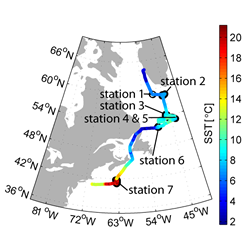HiWinGS
In the Fall of 2013 I participated in the High Wind Gas Exchange Study (HiWinGS) field campaign aboard the R/V Knorr at the invitation of B. Blomquist, B. Huebert, and C. Fairall.
The HiWinGS data set presents a unique opportunity to gain new insights on the poorly understood aspects of air-sea interaction under high winds and is at the core of my PhD disseration.

The HiWinGS cruise took place in the North Atlantic. We left Nuuk, Greenland, on October 9 and arrived at Woods Hole, USA on November 14, 2013. The ship’s track was chosen with the aim of maximizing the amount of time spent in the strongest winds. Along the track, the ship stopped at several stations for buoy deployments. Wind speeds exceeded 15 m s-1 25% of the time amounting to a total of 189 hours of wind speeds above 15 m s-1 of which 48 hours wind speeds greater than 20 m s-1. On October 25th (station 4), wind speeds exceeded 25 m s-1 with gusts of 35 m s-1 during the St Jude storm.

Publications:
- Brumer, S.E. et al., Wave-related Reynolds number parameterizations of CO2 and DMS transfer velocities. (2017)GRL, 44. doi: 10.1002/2017GL074979.pdf
- Blomquist, B.W., S.E. Brumer et al. (2017). Wind Speed and Sea State Dependencies of Air-Sea Gas Transfer: Results From the High Wind Speed Gas Exchange Study (HiWinGS). JGR Oceans, 2169-9291, doi: 10.1002/2017JC013181.pdf
- Brumer, S.E. et al. (2017) Whitecap Coverage Dependence on Wind and Wave Statistics as Observed during SO GasEx and HiWinGS. J. Phys. Oceanogr., 47, 2211–2235, doi: 10.1175/JPO-D-17-0005.1.pdf